David Zhang
Domain Gating Ensemble Networks for AI-Generated Text Detection
May 20, 2025Abstract:As state-of-the-art language models continue to improve, the need for robust detection of machine-generated text becomes increasingly critical. However, current state-of-the-art machine text detectors struggle to adapt to new unseen domains and generative models. In this paper we present DoGEN (Domain Gating Ensemble Networks), a technique that allows detectors to adapt to unseen domains by ensembling a set of domain expert detector models using weights from a domain classifier. We test DoGEN on a wide variety of domains from leading benchmarks and find that it achieves state-of-the-art performance on in-domain detection while outperforming models twice its size on out-of-domain detection. We release our code and trained models to assist in future research in domain-adaptive AI detection.
Compact Recurrent Transformer with Persistent Memory
May 02, 2025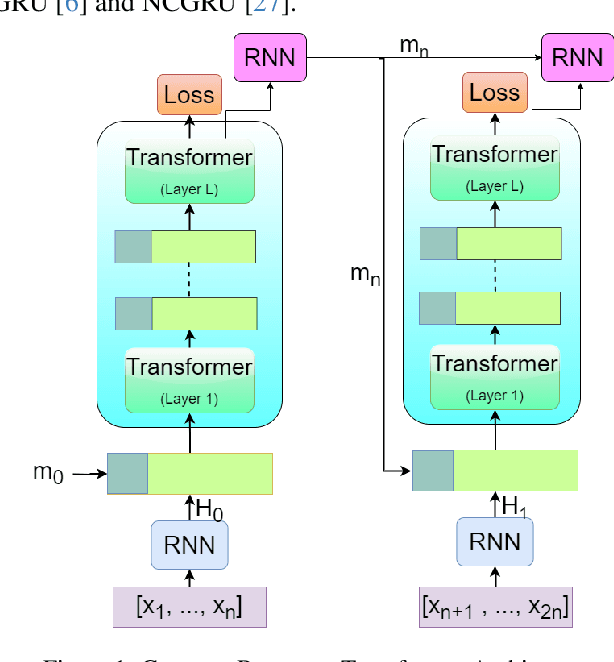

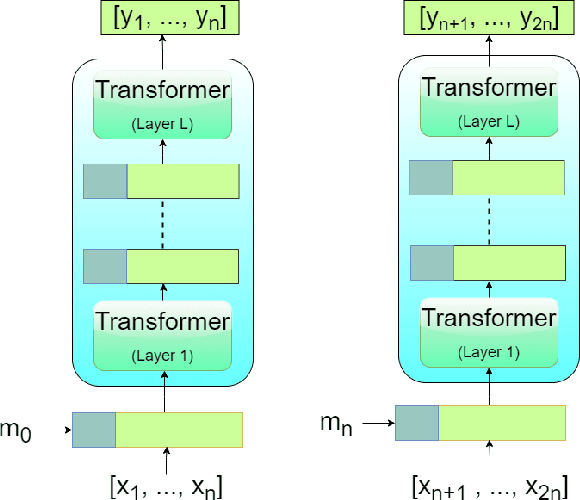
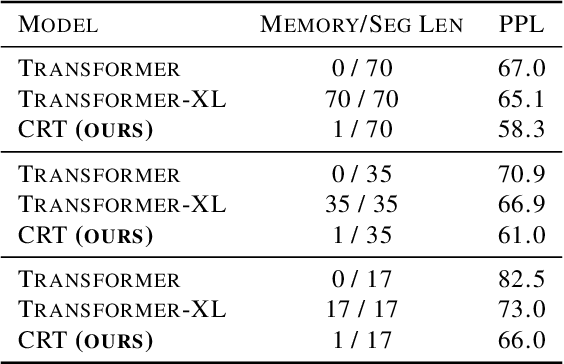
Abstract:The Transformer architecture has shown significant success in many language processing and visual tasks. However, the method faces challenges in efficiently scaling to long sequences because the self-attention computation is quadratic with respect to the input length. To overcome this limitation, several approaches scale to longer sequences by breaking long sequences into a series of segments, restricting self-attention to local dependencies between tokens within each segment and using a memory mechanism to manage information flow between segments. However, these approached generally introduce additional compute overhead that restricts them from being used for applications where limited compute memory and power are of great concern (such as edge computing). We propose a novel and efficient Compact Recurrent Transformer (CRT), which combines shallow Transformer models that process short local segments with recurrent neural networks to compress and manage a single persistent memory vector that summarizes long-range global information between segments. We evaluate CRT on WordPTB and WikiText-103 for next-token-prediction tasks, as well as on the Toyota Smarthome video dataset for classification. CRT achieves comparable or superior prediction results to full-length Transformers in the language datasets while using significantly shorter segments (half or quarter size) and substantially reduced FLOPs. Our approach also demonstrates state-of-the-art performance on the Toyota Smarthome video dataset.
CaLMFlow: Volterra Flow Matching using Causal Language Models
Oct 03, 2024Abstract:We introduce CaLMFlow (Causal Language Models for Flow Matching), a novel framework that casts flow matching as a Volterra integral equation (VIE), leveraging the power of large language models (LLMs) for continuous data generation. CaLMFlow enables the direct application of LLMs to learn complex flows by formulating flow matching as a sequence modeling task, bridging discrete language modeling and continuous generative modeling. Our method implements tokenization across space and time, thereby solving a VIE over these domains. This approach enables efficient handling of high-dimensional data and outperforms ODE solver-dependent methods like conditional flow matching (CFM). We demonstrate CaLMFlow's effectiveness on synthetic and real-world data, including single-cell perturbation response prediction, showcasing its ability to incorporate textual context and generalize to unseen conditions. Our results highlight LLM-driven flow matching as a promising paradigm in generative modeling, offering improved scalability, flexibility, and context-awareness.
Data-Driven Pixel Control: Challenges and Prospects
Aug 08, 2024

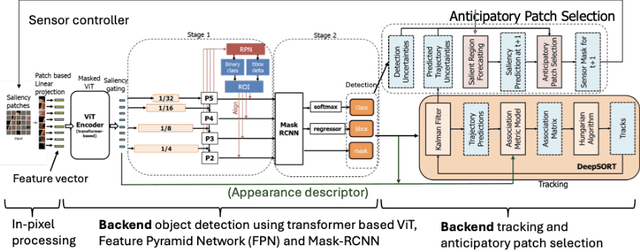

Abstract:Recent advancements in sensors have led to high resolution and high data throughput at the pixel level. Simultaneously, the adoption of increasingly large (deep) neural networks (NNs) has lead to significant progress in computer vision. Currently, visual intelligence comes at increasingly high computational complexity, energy, and latency. We study a data-driven system that combines dynamic sensing at the pixel level with computer vision analytics at the video level and propose a feedback control loop to minimize data movement between the sensor front-end and computational back-end without compromising detection and tracking precision. Our contributions are threefold: (1) We introduce anticipatory attention and show that it leads to high precision prediction with sparse activation of pixels; (2) Leveraging the feedback control, we show that the dimensionality of learned feature vectors can be significantly reduced with increased sparsity; and (3) We emulate analog design choices (such as varying RGB or Bayer pixel format and analog noise) and study their impact on the key metrics of the data-driven system. Comparative analysis with traditional pixel and deep learning models shows significant performance enhancements. Our system achieves a 10X reduction in bandwidth and a 15-30X improvement in Energy-Delay Product (EDP) when activating only 30% of pixels, with a minor reduction in object detection and tracking precision. Based on analog emulation, our system can achieve a throughput of 205 megapixels/sec (MP/s) with a power consumption of only 110 mW per MP, i.e., a theoretical improvement of ~30X in EDP.
Heterogeneous window transformer for image denoising
Jul 08, 2024Abstract:Deep networks can usually depend on extracting more structural information to improve denoising results. However, they may ignore correlation between pixels from an image to pursue better denoising performance. Window transformer can use long- and short-distance modeling to interact pixels to address mentioned problem. To make a tradeoff between distance modeling and denoising time, we propose a heterogeneous window transformer (HWformer) for image denoising. HWformer first designs heterogeneous global windows to capture global context information for improving denoising effects. To build a bridge between long and short-distance modeling, global windows are horizontally and vertically shifted to facilitate diversified information without increasing denoising time. To prevent the information loss phenomenon of independent patches, sparse idea is guided a feed-forward network to extract local information of neighboring patches. The proposed HWformer only takes 30% of popular Restormer in terms of denoising time.
SIAVC: Semi-Supervised Framework for Industrial Accident Video Classification
May 23, 2024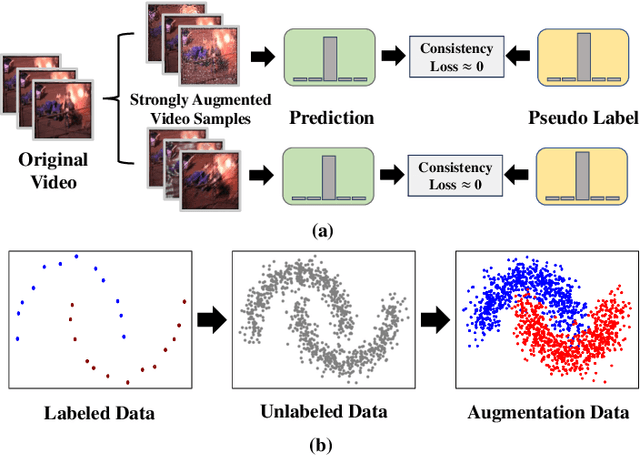
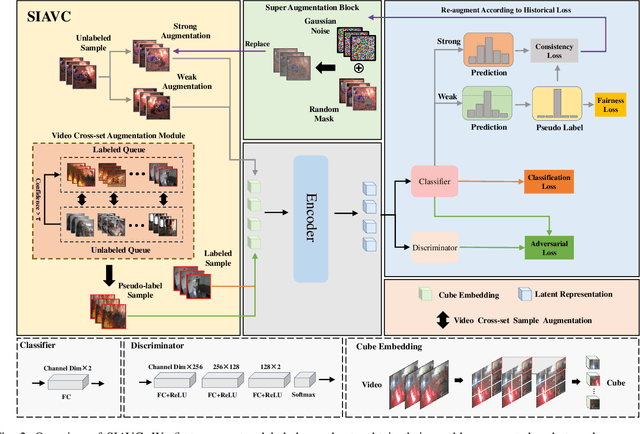
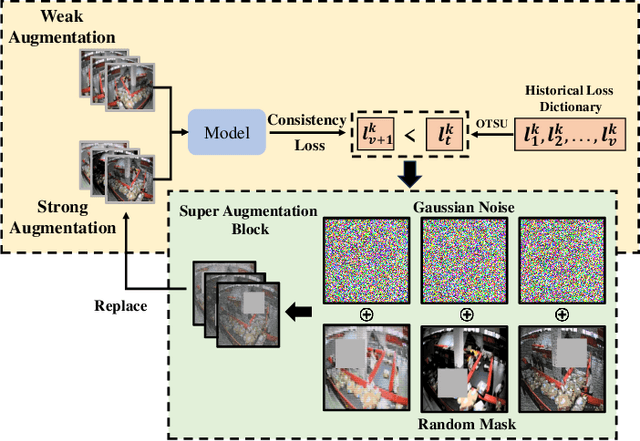
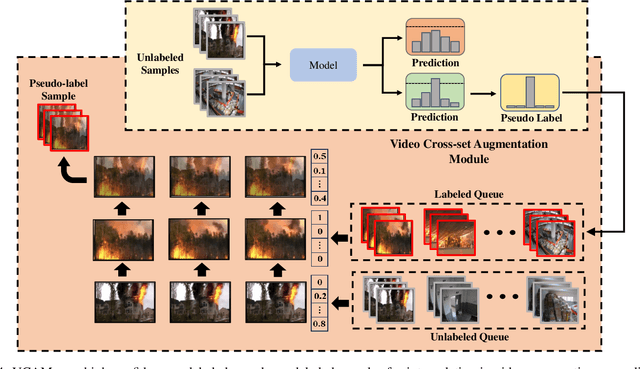
Abstract:Semi-supervised learning suffers from the imbalance of labeled and unlabeled training data in the video surveillance scenario. In this paper, we propose a new semi-supervised learning method called SIAVC for industrial accident video classification. Specifically, we design a video augmentation module called the Super Augmentation Block (SAB). SAB adds Gaussian noise and randomly masks video frames according to historical loss on the unlabeled data for model optimization. Then, we propose a Video Cross-set Augmentation Module (VCAM) to generate diverse pseudo-label samples from the high-confidence unlabeled samples, which alleviates the mismatch of sampling experience and provides high-quality training data. Additionally, we construct a new industrial accident surveillance video dataset with frame-level annotation, namely ECA9, to evaluate our proposed method. Compared with the state-of-the-art semi-supervised learning based methods, SIAVC demonstrates outstanding video classification performance, achieving 88.76\% and 89.13\% accuracy on ECA9 and Fire Detection datasets, respectively. The source code and the constructed dataset ECA9 will be released in \url{https://github.com/AlchemyEmperor/SIAVC}.
Perceptive self-supervised learning network for noisy image watermark removal
Mar 04, 2024Abstract:Popular methods usually use a degradation model in a supervised way to learn a watermark removal model. However, it is true that reference images are difficult to obtain in the real world, as well as collected images by cameras suffer from noise. To overcome these drawbacks, we propose a perceptive self-supervised learning network for noisy image watermark removal (PSLNet) in this paper. PSLNet depends on a parallel network to remove noise and watermarks. The upper network uses task decomposition ideas to remove noise and watermarks in sequence. The lower network utilizes the degradation model idea to simultaneously remove noise and watermarks. Specifically, mentioned paired watermark images are obtained in a self supervised way, and paired noisy images (i.e., noisy and reference images) are obtained in a supervised way. To enhance the clarity of obtained images, interacting two sub-networks and fusing obtained clean images are used to improve the effects of image watermark removal in terms of structural information and pixel enhancement. Taking into texture information account, a mixed loss uses obtained images and features to achieve a robust model of noisy image watermark removal. Comprehensive experiments show that our proposed method is very effective in comparison with popular convolutional neural networks (CNNs) for noisy image watermark removal. Codes can be obtained at https://github.com/hellloxiaotian/PSLNet.
CodeIt: Self-Improving Language Models with Prioritized Hindsight Replay
Feb 07, 2024



Abstract:Large language models are increasingly solving tasks that are commonly believed to require human-level reasoning ability. However, these models still perform very poorly on benchmarks of general intelligence such as the Abstraction and Reasoning Corpus (ARC). In this paper, we approach ARC as a programming-by-examples problem, and introduce a novel and scalable method for language model self-improvement called Code Iteration (CodeIt). Our method iterates between 1) program sampling and hindsight relabeling, and 2) learning from prioritized experience replay. By relabeling the goal of an episode (i.e., the target program output given input) to the realized output produced by the sampled program, our method effectively deals with the extreme sparsity of rewards in program synthesis. Applying CodeIt to the ARC dataset, we demonstrate that prioritized hindsight replay, along with pre-training and data-augmentation, leads to successful inter-task generalization. CodeIt is the first neuro-symbolic approach that scales to the full ARC evaluation dataset. Our method solves 15% of ARC evaluation tasks, achieving state-of-the-art performance and outperforming existing neural and symbolic baselines.
Towards Efficient Hyperdimensional Computing Using Photonics
Nov 29, 2023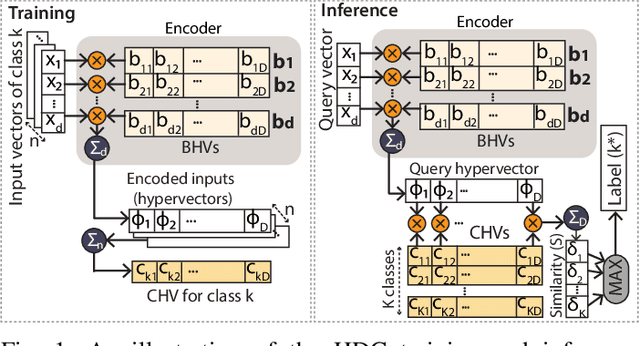

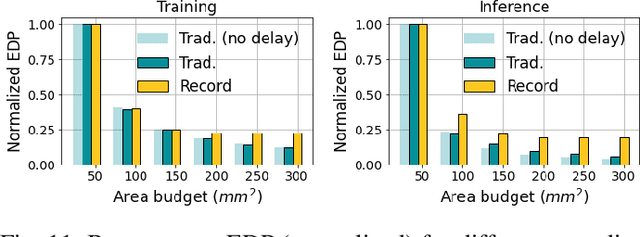

Abstract:Over the past few years, silicon photonics-based computing has emerged as a promising alternative to CMOS-based computing for Deep Neural Networks (DNN). Unfortunately, the non-linear operations and the high-precision requirements of DNNs make it extremely challenging to design efficient silicon photonics-based systems for DNN inference and training. Hyperdimensional Computing (HDC) is an emerging, brain-inspired machine learning technique that enjoys several advantages over existing DNNs, including being lightweight, requiring low-precision operands, and being robust to noise introduced by the nonidealities in the hardware. For HDC, computing in-memory (CiM) approaches have been widely used, as CiM reduces the data transfer cost if the operands can fit into the memory. However, inefficient multi-bit operations, high write latency, and low endurance make CiM ill-suited for HDC. On the other hand, the existing electro-photonic DNN accelerators are inefficient for HDC because they are specifically optimized for matrix multiplication in DNNs and consume a lot of power with high-precision data converters. In this paper, we argue that photonic computing and HDC complement each other better than photonic computing and DNNs, or CiM and HDC. We propose PhotoHDC, the first-ever electro-photonic accelerator for HDC training and inference, supporting the basic, record-based, and graph encoding schemes. Evaluating with popular datasets, we show that our accelerator can achieve two to five orders of magnitude lower EDP than the state-of-the-art electro-photonic DNN accelerators for implementing HDC training and inference. PhotoHDC also achieves four orders of magnitude lower energy-delay product than CiM-based accelerators for both HDC training and inference.
Efficient Model Adaptation for Continual Learning at the Edge
Aug 03, 2023



Abstract:Most machine learning (ML) systems assume stationary and matching data distributions during training and deployment. This is often a false assumption. When ML models are deployed on real devices, data distributions often shift over time due to changes in environmental factors, sensor characteristics, and task-of-interest. While it is possible to have a human-in-the-loop to monitor for distribution shifts and engineer new architectures in response to these shifts, such a setup is not cost-effective. Instead, non-stationary automated ML (AutoML) models are needed. This paper presents the Encoder-Adaptor-Reconfigurator (EAR) framework for efficient continual learning under domain shifts. The EAR framework uses a fixed deep neural network (DNN) feature encoder and trains shallow networks on top of the encoder to handle novel data. The EAR framework is capable of 1) detecting when new data is out-of-distribution (OOD) by combining DNNs with hyperdimensional computing (HDC), 2) identifying low-parameter neural adaptors to adapt the model to the OOD data using zero-shot neural architecture search (ZS-NAS), and 3) minimizing catastrophic forgetting on previous tasks by progressively growing the neural architecture as needed and dynamically routing data through the appropriate adaptors and reconfigurators for handling domain-incremental and class-incremental continual learning. We systematically evaluate our approach on several benchmark datasets for domain adaptation and demonstrate strong performance compared to state-of-the-art algorithms for OOD detection and few-/zero-shot NAS.
 Add to Chrome
Add to Chrome Add to Firefox
Add to Firefox Add to Edge
Add to Edge